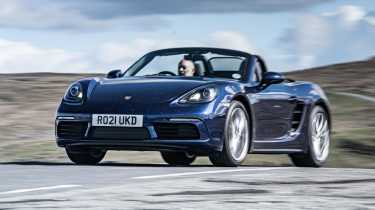Porsche 718 Boxster review – the benchmark convertible sports car
The petrol-engined Boxster isn't long for this world, but it still represents the definitive open-top sports car experience
We can’t really think of another car that has so consistently performed at such a high level for such a long time as the Porsche Boxster. It may have picked up the unfair tag of being the poor person’s 911, but we’d hazard a guess few Boxster owners have ever felt short-changed after a day behind the wheel.
So even nine years into the 718 generation – and with its EV replacement on the horizon – the Boxster remains one of the best sports cars on sale, with a sizeable caveat based around the lower half of the range. This is almost entirely down to the fitment of Porsche’s turbocharged flat-four engine – a decision that has elicited a fair amount of criticism, and for good reason. Yet this only affects the base and S models, with the GTS now running a slightly de-tuned version of the 4-litre flat-six from the Boxster Spyder.
> Porsche 718 Boxster Spyder RS 2025 review – unapologetically hardcore, undeniably brilliant
A positioning realignment along with the 718 update also affected the Cayman, the entry price of which dropped below the soft-top Boxster, making it now the more expensive mid-engined model. So there are a few chinks in the Boxster’s armour, but choose wisely and its best attributes remain, keeping it a keystone model for both Porsche and its competitors.
Porsche 718 Boxster: in detail
- Engine, gearbox and technical highlights > The flat-fours are fickle engines, and manuals are geared too long. Sixes are brilliant
- Performance and 0-62mph time > Even the meekest Boxster posts a respectable 5.1sec 0-62mph time, with the GTS dipping into the mid-4s
- Ride and Handling > Always a strong point for the Boxster, the new 718 builds on the excellent foundations of the previous generations
- MPG and running costs > The flat-four’s efficiency varies a lot depending on use; sixes are more consistent
- Interior and tech > Superbly built, but starting to feel its age if you’re into gadgets. Ergonomics are top-notch though
- Design > The basic design is familiar; looks tight and compact compared to more modern rivals
Prices, specs and rivals
The 718 Boxster has steadily risen in price over the years, but at £55,800, it competes in the sports car heartland it always has. For this price though, you get halogen headlights, a plastic dashboard and tiny (in context) 18-inch wheels making it look and feel like the base model it is. Get busy with the options list and elements such as LED headlights and proper leather can be specced, but they add up quickly. Porsche’s PCM system is clear and easy to use, but the basic stereo is pretty poor and struggles to overcome road and wind noise. The BOSE sound system upgrade is well worth considering.
More reviews
An extra £4200 buys the Boxster Style Edition, which adds a number of cosmetic upgrades to the base car. These include a contrasting decal pack, black exhaust tips and the option of Porsche's iconic Rubystar red paint colour (which is more pink than red in reality). Bi-xenon headlights, a heated steering wheel and front and rear ParkAssist are included in the price.
For £65,800, the Boxster S adds various performance upgrades, larger 19-inch alloy wheels, twin exhaust outlets and real leather seats. From here though, things get a little more serious, and for the better. The six-cylinder GTS 4.0 costs from £77,300, and despite you needing to shell out a further £1365 for the GTS interior package (cheeky), the basics are there, including bespoke front and rear fascias and a very tasty set of 20-inch alloy wheels.
Notable options across all Boxster models include the excellent seven-speed PDK dual-clutch gearbox and Sport Chrono pack which has a launch control function and a useless (but pretty) stopwatch atop the dash. Adaptive dampers dubbed PASM are available on most models, as are the eye-wateringly expensive carbon-ceramic brakes (possibly a bit of overkill on the base car with 296bhp).
Dynamically, few if any rivals can hold a candle to the Boxster in any form. The Alpine A110 (£54,490) offers a more delicate and nuanced driving experience, but has compromises in everyday useability. The Lotus Emira, on the other hand, is undoubtedly expensive (the four-cylinder version costs £89,500) and doesn't quite have the polished, sophisticated feel of the Porsche. In the right circumstances though, it's deeply exciting.
Buyers looking for the open-top experience are running out of options these days, particularly with Audi's TT having ceased production. The BMW Z4 is one alternative, and with the manual-equipped £65,710 Handschalter now an option, it's more appealing than ever – even then, though, it's nothing like as sharp as the Boxster to drive.





